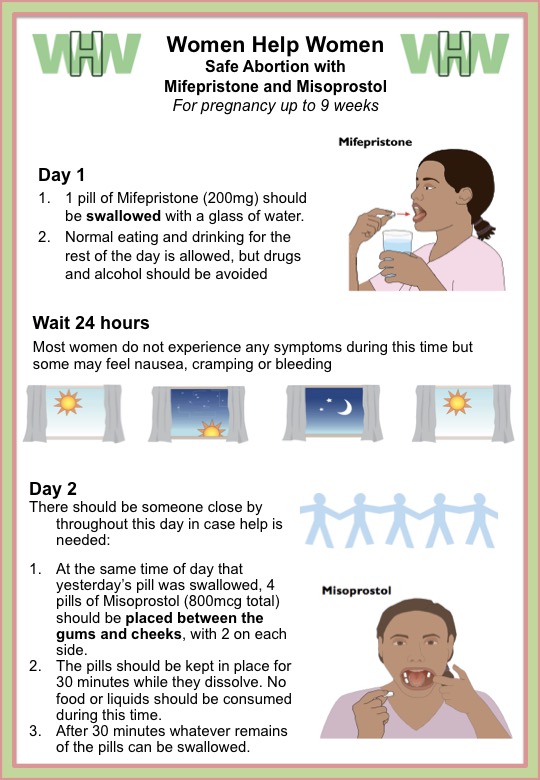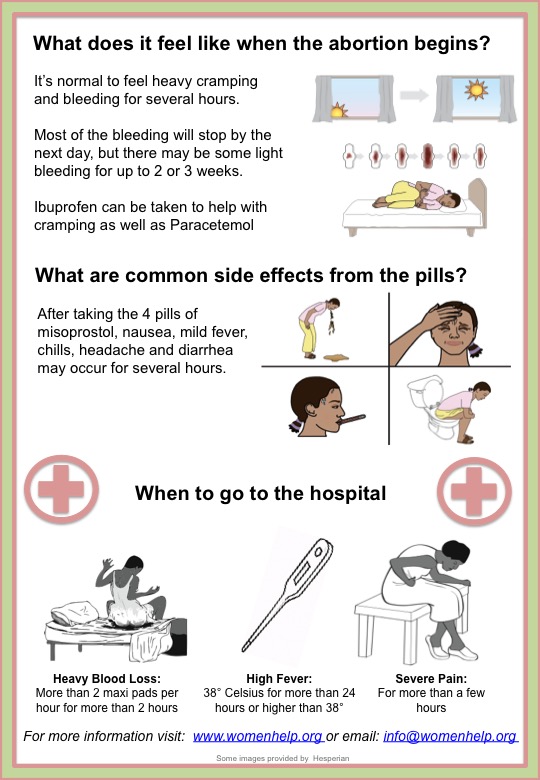A woman should not use abortion pills if:
- She is being forced by someone to have an abortion.
- She is more than 9 weeks pregnant.
- She is allergic to mifepristone or misoprostol.
- She has an IUD (intrauterine device – it should be removed before using the medicines).
- She has any of the following conditions: chronic adrenal failure, hemorrhagic disorders or bleeding disorders/diseases, porphyries.
- She has an ectopic pregnancy (a pregnancy outside the womb).
- She cannot get to a hospital or doctor within two hours.
- She is alone. She should ask a partner or a friend to stay with her while she uses the medicines.
What is important to know before using the abortion pills?
- To confirm the pregnancy.
- To know the length of pregnancy. This can be best estimated by counting the days since the first day of the last menstruation. To easily calculate the length of pregnancy, use the pregnancy calculator on the right hand side of this page.
- To make a plan.
- It is important to have someone for support and in case of a medical complication, although complications are very rare. It is good to get ibuprofen for the cramps. If a woman is nauseous due to pregnancy, she can consider taking an anti-nausea medicine so that she does not vomit up the pills.
- Plan to start the medicines as soon as possible. An abortion with pills at home is safest and most effective if done before 9 weeks of pregnancy.
- On the day of taking the medicines, one can eat and drink normally. The medications don’t need to be taken on an empty stomach. Avoid drinking alcohol or eating heavy meals while taking the medicines. Be sure to keep the medicines away from children.
- Think about what day you want to take the misoprostol (the second pill that provokes cramps and bleeding), and on that day, try to be somewhere comfortable and near a bathroom.
- To confirm that there are no serious medical conditions or an IUD. If she has an IUD it must be removed before using misoprostol.
- To confirm that there is a possibility to get to medical care in case of an emergency within 2 hours, and make a plan for how to get there in case it’s needed.
How to use misoprostol for safe abortion before 12 weeks of pregnancy?
Until 12 weeks of pregnancy, a woman needs a total of 2400 mcg of misoprostol.
She needs: 12 pills of 200 micrograms each (or 24 pills of 100 micrograms each)
3 doses of pills need to be taken, 800 mcg each time.
Step 1- A woman should put 4 pills of 200 mcgs (or 8 pills of 100 mcgs) misoprostol under the tongue. The pills should stay for at least 30 minutes, or until the tablets are dissolved! She can swallow her saliva, but NOT the pills. After 30 minutes it is ok to swallow what remains of the pills.
Step 2- After 3 hours she should repeat: put another 4 pills of 200 mcgs (or 8 pills of 100 mcgs) misoprostol under the tongue. The pills should stay for at least 30 minutes, or until the tablets are dissolved.
Step 3- After 3 hours she should take the last 4 pills of 200 mcgs (or 8 pills of 100 mcgs) under the tongue again for a third time. The pills should stay for at least 30 minutes, or until the tablets are dissolved.
In between the doses of misoprostol, one can eat and drink normally. Do not drink alcohol, as it is important to pay attention to what is happening.
The success rate is approximately 85%.
This means that 8 to 9 women of every 10 women who use misoprostol correctly will have a safe abortion using this procedure.

How to use mifepristone plus misoprostol for safe abortion?
Until 10 weeks of pregnancy, a woman needs 1 tablet of mifepristone (200 mg) and 4 tablets of misoprostol (200 mcg each).
Step 1– A woman should swallow one tablet of mifepristone.
Step 2– 24 hours later: a woman should put 4 tablets of misoprostol in the cheek between the gum and lower teeth, 2 on each side. (See a picture of how to use the misoprostol underneath).
The pills should stay for at least 30 minutes, or until the tablets are dissolved. She can swallow her saliva, but NOT the pills. After 30 minutes it is ok to swallow what remains of the pills.
It’s better to avoid eating or drinking during these 30 minutes so that the pills are not accidently swallowed. Saliva can be swallowed. After 30 minutes if there are any remains of the tablets, they can be swallowed.

What will happen after using mifepristone plus misoprostol, or misoprostol alone?
Usually women do not feel anything after taking the mifepristone (the first pill that is swallowed). A few women have reported experiencing some nausea, dizziness, or very light bleeding.
After taking misoprostol, you may initially feel side effects from the misoprostol, including a light fever, chills, diarrhea, and nausea. These are normal side effects and usually pass within a few hours or so of using the misoprostol.
The misoprostol will cause cramping and bleeding as the uterus contracts and pushes out the pregnancy. If a woman uses mifepristone plus misoprostol, the cramps and bleeding usually start within 1-5 hours after using the misoprostol, but some women have cramps sooner and some later; every woman’s body is different. If a woman is using misoprostol alone, most women will start bleeding within 7 hours after using misoprostol; however it may start several hours sooner or later. It can be different in every case.
Bleeding is usually heavier than a period and often accompanied by clots. The heaviest bleeding typically occurs 2-5 hours after using misoprostol and usually slows within 24 hours. Some women may pass clots days or even weeks later. This is common and is not dangerous, if there are no symptoms of a complication.
Ibuprofen is the most effective painkiller for cramps. You can also use other NSAID’s like Naproxen and Diclofenac for the pain. For some women, a hot water bottle on the belly brings relief. Please read the instructions on the package of painkillers you obtained for the maximum doses you can use.
During and after the abortion, you should use sanitary pads, NOT tampons. This is to prevent infection and also to measure the amount of bleeding to make sure it is within safe levels.

What are the symptoms of complications?
Complications after early medical abortions are rare, and include severe bleeding and infection. A woman should go to the doctor or hospital if she has any of the signs of complication below:
- Severe bleeding (more than 2 maxi pads soaked every hour for more than 2 hours in a row).
- Severe abdominal pain that isn’t relieved with painkillers or continues for 2-3 days.
- A fever that reaches 102o F at any point or a fever of over 100o F for more than 24 hours.
- Abnormal vaginal discharge (unusual greenish or yellowish color, and/or strong unpleasant odor).
Any person who knows someone used abortion medication to end their own pregnancy might feel obliged to report it, though they are generally not required to do so. If a woman seeks medical attention, she does not have to say she used medicines. The person seeking medical attention can say she is having a miscarriage. The symptoms and treatment for complications of a miscarriage are the same as those for complications of medical abortion. Miscarriage occurs naturally in 15-20% of all pregnancies, and all hospitals in the USA can treat any complications of miscarriage. There are currently no tests that can identify the medicines in the woman’s blood or urine. There is no way that the doctor can know she has taken medicines unless the patient discloses or has the pills on or in their body (in their mouth or vagina).
It is important to remember that some people in the United States have faced arrest or jail for ending their own pregnancies. Although abortion itself is legal, those who end their own pregnancies may risk unjustified arrest and imprisonment under laws that require the abortion pills be given by licensed health care workers and that criminalize self-induced abortion. Such laws vary from state-to-state. In spite of these laws, any person who is experiencing a rare complication from a medication abortion can seek follow up care, because all clinicians can treat a miscarriage, and cannot detect the pills.
What if there is no bleeding after using the misoprostol?
If after 24 hours the woman has no bleeding, and she is sure that she is pregnant AND that the pregnancy develops in the uterus (not an ectopic pregnancy), then the medicines did not work.
If a woman bled less than her normal menstrual period, if she didn’t see any clots and thinks the abortion didn’t occur, she can use 400 more mcg of misoprostol (2 tablets of 200 mcg or 4 tablets of 100 mcg) under the tongue for 30 minutes. This is the standard treatment for an incomplete miscarriage.
What happens after the abortion?
On average, women bleed for 9 -14 days after doing a medical abortion. Some women bleed or pass clots for as long as 4 weeks. After the first few days of more intense bleeding some women will have little or no bleeding, some will have bleeding that stops and starts, and others will have bleeding similar to a menstrual period for several weeks.
Most women are able to know if the abortion was successful quite soon after using the medicines, because pregnancy symptoms disappear quite quickly and/or some women might see the embryonic sac. Even if the woman feels she is not pregnant anymore, it is important to make sure the abortion was successful. Women should either do an ultrasound about 10 days after the medical abortion or do a pregnancy test 3-4 weeks after the abortion.
Sometimes the pregnancy test is still positive 3 weeks after taking the medicines because the pregnancy hormones are still in the blood. If that is a case, the pregnancy test should be repeated in another few days or have an ultrasound.
If an ultrasound shows that a woman is no longer pregnant but that there are remains in the womb, AND if there are no symptoms of a complication, there is NO need any surgical intervention (D and C, curettage, scraping). It is advised to wait until the body expels the tissues naturally.
The menstrual period should return 4-6 weeks after the abortion.
Although it may be several weeks before menstruation comes back again, your fertility returns to normal right away. If a woman does not wish to become pregnant straight after the abortion, it is very important to start using contraceptives immediately. For information about contraceptive options,
How to check if the pills worked?
Most women are able to know if the abortion was successful quite soon after using the medicines, because pregnancy symptoms disappear quite quickly and/or some women might see the embryo or embryonic sac. Even if the woman feels she is not pregnant anymore, it is important to make sure the abortion was successful. Women should either do an ultrasound 10 days after the medical abortion or do a pregnancy test 3-4 weeks after the abortion.
Urine pregnancy test – Even though HcG (human chorionic gonadotrophin – the pregnancy hormone) drops rapidly after abortion, this hormone can stay in a woman’s body for several weeks after a pregnancy. Pregnancy tests are still inconclusive or falsely positive several weeks after the abortion. As many as 66% of the pregnancy tests done 2 weeks after abortion are positive, even when the woman is no longer pregnant. It is better to wait 3-4 weeks before doing a pregnancy test otherwise a woman might have a false positive.
Ultrasound – Although an ultrasound can confirm if the abortion was successful (pregnancy was expelled) right after the abortion, women are advised to wait 2 weeks before having a scan. An early ultrasound may lead to a wrong diagnosis of incomplete abortion and unnecessary vacuum aspiration or curettage. Medical abortion involves a process that can last for several weeks before the uterus is empty, so remains in the uterus are not a sign of an incomplete abortion. There is no need for medical attention if there are no other signs of complication.
Blood pregnancy test – Blood pregnancy tests are a good alternative to ultrasound, especially if it is possible to do 2 blood pregnancy tests. Women can do a blood pregnancy test when they do the abortion (it can also be done just before or after the abortion) and then repeat the test 4-5 days after the abortion. If the level of hormone called HcG decreases this means the abortion was successful.




